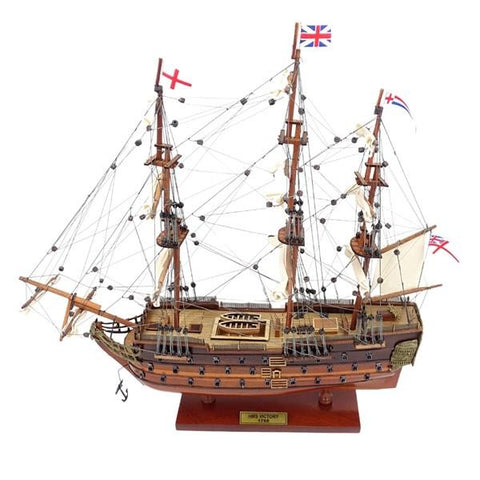
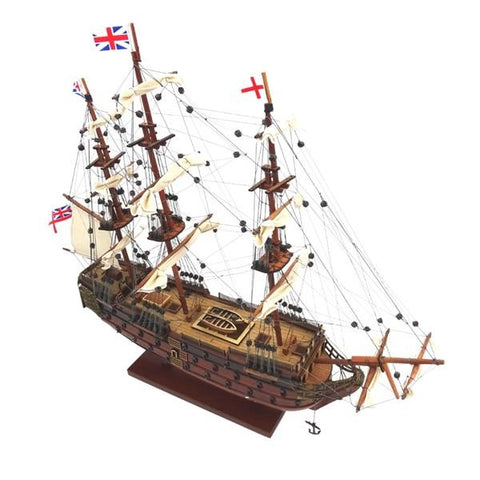
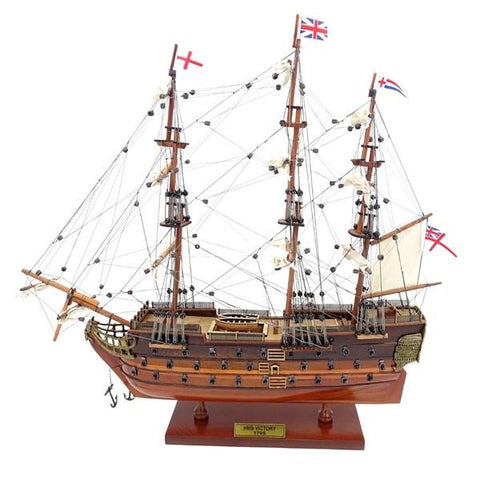
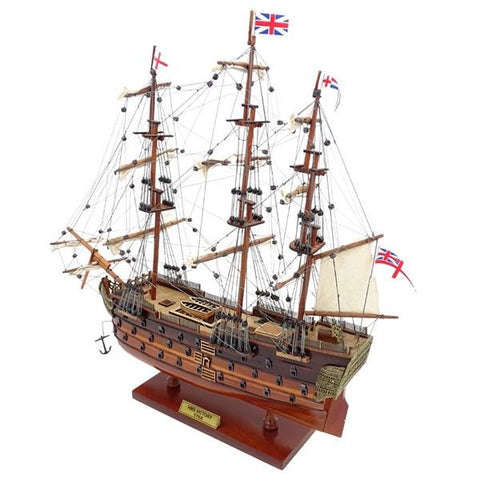
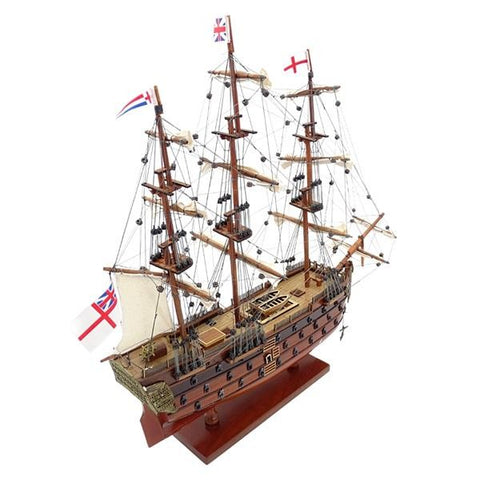

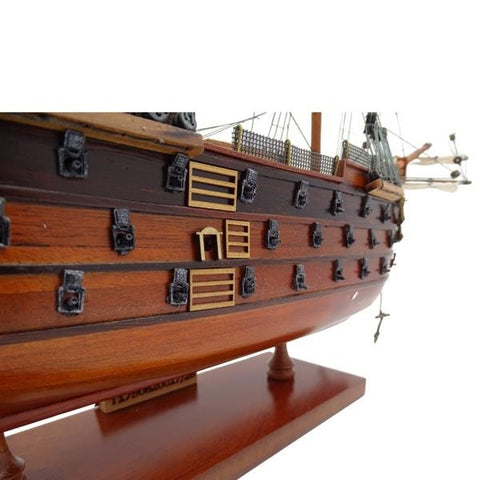
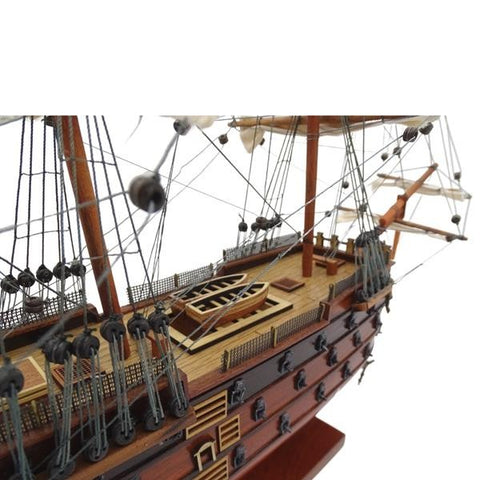
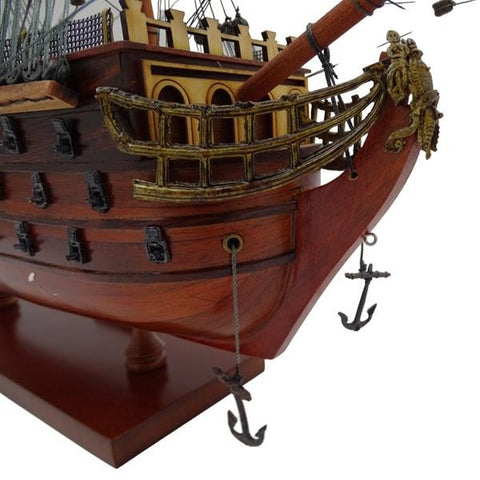
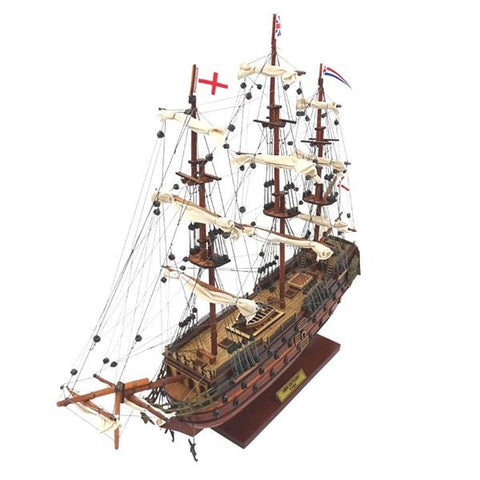
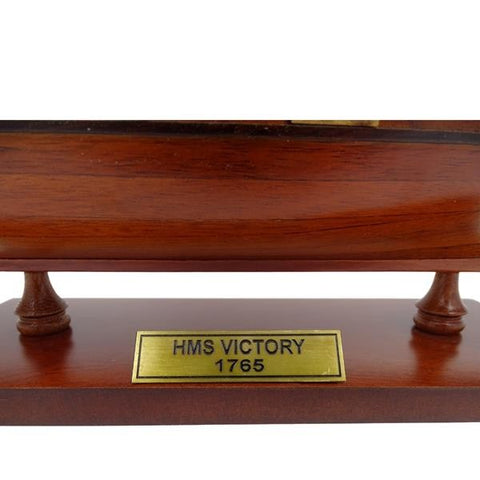


Victory - tall ship model VIC45
Victory - aukšto laivo modelis VIC45 Tai vieno garsiausių istorijoje burlaivių - britų karinio jūrų laivyno burlaivio "HMS Victory", pastatyto 1759-1765 m. Čatamo laivų statykloje, modelis.
Victory - tall ship model VIC45 This is a model of one of the most famous sailing ships in history - HMS Victory - a sailing vessel of the British Navy, built between 1759–1765 at the Chatham Dockyard. Our model is characterized by great attention to detail. It has been faithfully recreated and scaled on the basis of historical plans and drawings. Handcrafted mainly from exotic wood, but also from metal and natural materials in a manner similar to the construction of the original ship. The production of the model took several hundred hours. Production of arts and crafts. Carefully refined elements such as sails, 3 rows of metal cannons on each side of the ship's side, metal steering wheel, lifeboats, metal lamps, rich ornamentation. The model does not contain any plastic parts. It is fully assembled and ready to be set up.The model sits on a wooden base with the name of the ship on it.Careful packaging - model protected by a wooden cage inserted into a cardboard box. A great gift for a history lover, a perfect decorative element that will give your interior a unique character. Dimensions:Length 47 cmHeight 52 cm The name for the ship was chosen to commemorate the victories of the British Army during the Seven Years' War at the Battle of Minden and at the Battle of Abraham's Plain, as well as at the Sea Battles of Lagos and Quiberon Bay. The construction cost was £ 63,176 3 shillings, which is about £ 50 million at today's prices. Wood from 6,000 trees was used for the construction, and 90% of the material used was oak.The first years of the ship's service expired in reserve. For 13 years he stood with the masts down at the mouth of the Medway River. In March 1778, John Lindsay was appointed the first commander of the ship. However, in May of the same year, the flag of the ship was raised by Admiral Augustus Keppel, and Rear Admiral John Campbell took command of the ship. At that time, the ship was armed with iron 32 and 42 lb (30 cannons) cannons, 30 24 pounder cannons and 40 12 pound cannons. Two more 68 pound caronades were added later. Under the command of Admiral Keppel, the ship took part in the First Battle of Ushant. In December 1781, under the command of Commander Henry Cromwell and under the flag of Rear Admiral Richard Kempenfeld, she took part in the Second Battle of Ushant. However, in 1797, the ship, under the command of Commander Robert Calder and under the flag of Admiral Sir John Jervis, took part in the Battle of Cape St. Vincent. After the necessary renovation, the number of guns increased to 104. During the service, the painting of the ship was changed. Trafalgar - the most famous naval battle involving HMS Victory.The ships of the Franco-Spanish fleet sailed north in line formation. Around noon on October 21, 1805. at Cape Trafalgar, British Admiral Horatio Nelson attacked the enemy with two columns flowing across the enemy's formation. Such a battle plan was designed to cut off the enemy's most powerful ships, who were outnumbered, and to deal with the rest.The right column of 15 ships under the command of C. Collingwood on the Royal Sovereign was to cut off the rear guard, while the left, 12-ship column under the command of Nelson on the Victory was to cut off the center. While carrying out this maneuver, the French and the Spaniards kept firing at the approaching British ships, wreaking havoc. Due to the weak wind, the British columns moved slowly, unable to respond with fire for almost an hour. Victory was still under fire At 12:45 Victory crossed the enemy line between Bucentaure and Redoutable. As the two fleets approached, there was an exchange of small arms fire. French gunners from Redoutable stabbed the English from above with rigging. The British fleet commander, distinguished as usual in his usual dress, was an easy target for them. At 1:15 p.m., a French sailor shot him fatally in the spine. The admiral ordered him to be brought below deck so that the crew would not notice. He died at 4:30 PM. The battle was won, however. Thanks to his high morale and the tactics used, Nelson achieved his last victory. The Allies lost 22 ships, about 3,250 killed, about 2,500. injured and approx. 7 thousand. taken captive. 449 British sailors were killed. This battle marked the beginning of the great British hegemony on the seas of the world, contributing significantly to the establishment of the British colonial empire.After that Victory underwent renovation. In the following years, it made cruises as part of the blockade of the French coasts, and also sailed twice under the flag of Admiral James Saumarez in campaigns in the Baltic Sea. The ship ended her service on November 7, 1812, when it was changed to a hulk and moored at Gosport. Thanks to the decision of the former commander of the ship, and later First Lord of the Admiralty Thomas Hardy, the ship was not intended for demolition. In 1889, the ship was converted into the Naval School of Telegraphy. In this capacity, the ship served until 1904. After the end of World War I, a special fund called "Save the Victory Fund" was established to save the ship, which was organized by the British Society for Marine Discovery, and it also received support from the then British government. Finally, on January 12, 1922, Victory was seated in the oldest working dock in the world: Portsmouth Dock 2 for restoration. In 1928, King George V officially completed the restoration of the ship. Today, HMS Victory is housed in a museum, but is officially still the flagship of the British Royal Navy. As a museum ship, Victory is visited by approximately 350,000 visitors each year. The ship is currently in Portsmouth.

